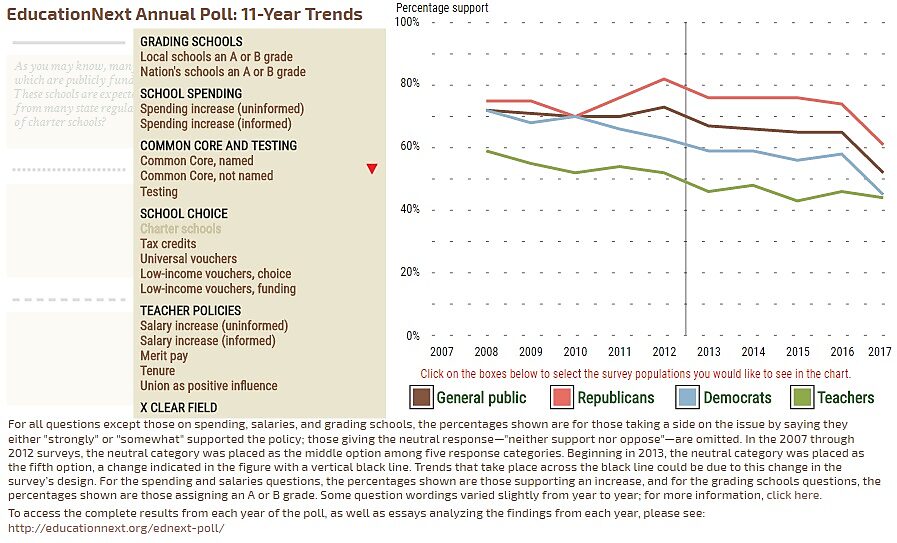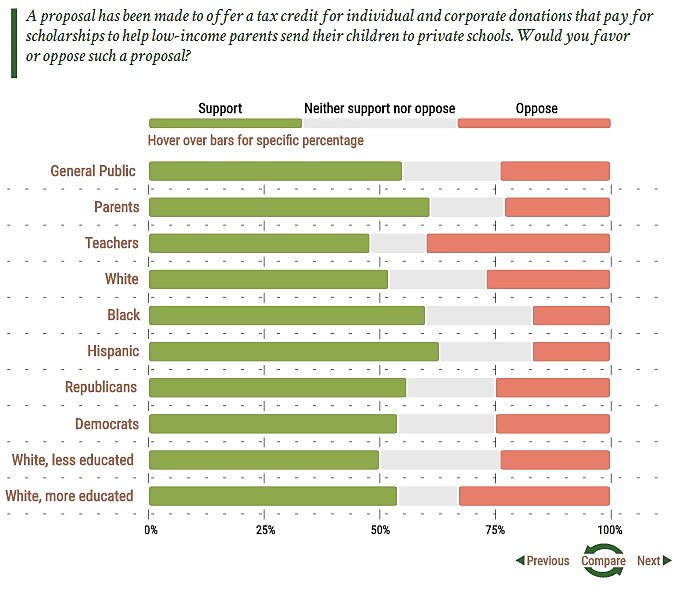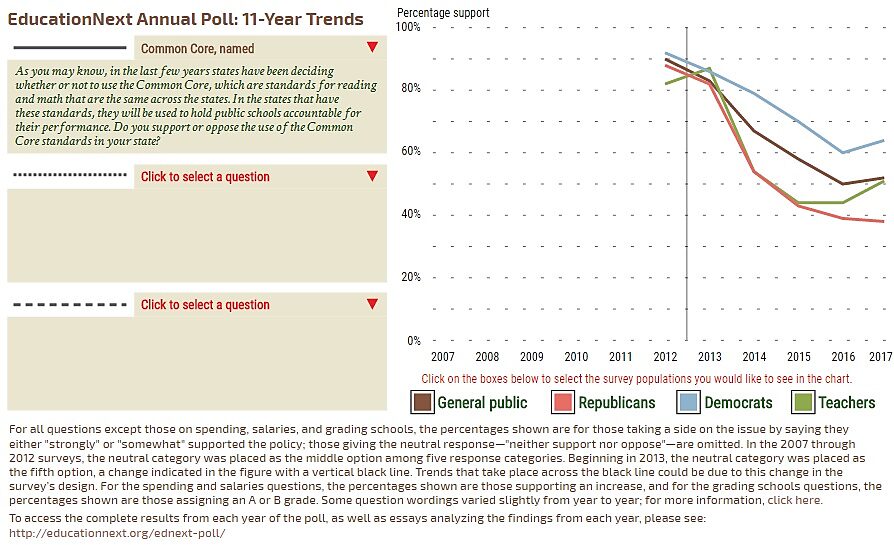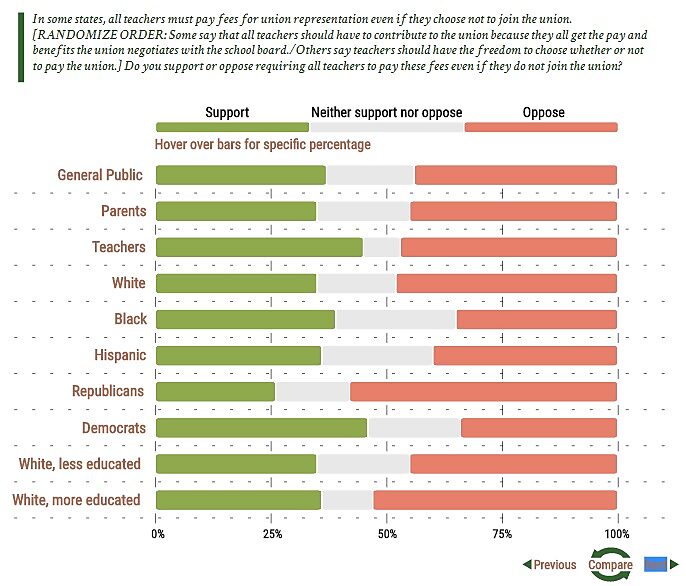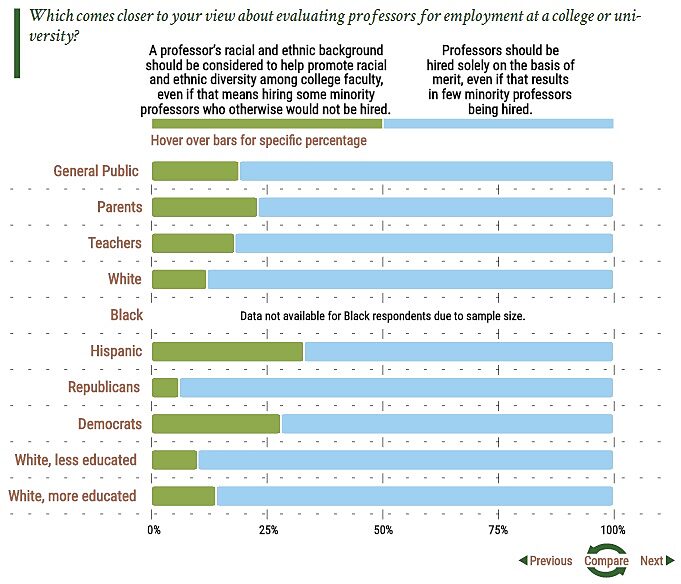The annual Education Next gauge of public opinion on numerous education issues is out, and as always it offers lots to contemplate, including special questions this year on the “Trump effect.” I won’t hit everything, just what I see as the highlights.
School Choice
The poll’s headline grabber is a big drop in support for charter schools, public schools run by ostensibly private entities but subject to many public school controls, especially state standards and testing. When people with neutral opinions were removed, 52 percent of respondents approved of “formation” of charters—that word likely made some difference—down from a peak of 73 percent in 2012. With neutral answers included, only 39 percent of the general public supported charters.
The good news is that support for private school choice programs—superior to charters because they offer access to far wider options, including religious schools—saw upticks. Scholarship tax credits remain the choice champ, with support (absent neutral respondents) rising from 65 percent to 69 percent. With neutrals, support stood at 55 percent of the general public. For vouchers, a lot depends on question wording, but without a loaded emphasis on “government funds,” support (minus neutrals) stood at 55 percent, up from 50 percent the previous year. With neutrals, support was at 45 percent, with 37 percent opposing. Education savings accounts—basically, money parents can use not just for tuition, but other education expenses like tutoring or buying standalone courses—garnered only 37 support from the general public, but the concept is pretty new and people may just not have wrapped their heads around it yet.
Why the big drop in charter support but improved backing of private school choice? As always, wording, question order, and other artifacts of the poll itself matter, but assuming those aren’t the major causes of the results, perhaps the answer is that charters, as a compromise between empowering parents and maintaining government control, have traditionally tended to have the highest profile bipartisan support of the various choice mechanisms. As a result of Trump-driven polarization, perhaps they have also had the most visible schisms, maybe casting a more negative light on them. Or maybe people have started to perceive, as Education Secretary Betsy DeVos borrowed from Rick Hess to warn, charters are becoming “the Man” they were supposed to replace.
Spending
It is always instructive to see how much people think we spend on public schools, how much we actually spend, and whether the truth sets people free of the assumption that we need to spend more. As in the past, the poll finds that people greatly underestimate how much their districts spend per-pupil, with respondents guessing only about 69 percent of the actual expenditure. The average respondent thought their local district spent $8,877 per student, when in fact their district shelled out $12,899. When actual spending is not provided, 54 percent of respondents think their districts should increase outlays. When it is furnished, that drops to 39 percent. Of course, none of this actually says what the “right” amount of spending is, because we do not know what that is—we don’t have competitive markets that let us see how efficiently education can be provided.
Common Core
With the passage of the Every Student Succeeds Act, which at least in spirit puts states back in charge of their own standards and tests, and with many states likely loathe to quickly revisit the process of overhauling their systems, this once burning issue has dwindled to smoldering. Perhaps that is why after Core support cliff-dove between 2012 and 2016—with neutral responses removed, it plummeted from 90 percent to 50 percent—it caught a bit of an updraft this year, with support lifting to 52 percent. Add the neutral answers, though, and support sits at just 41 percent, and that’s with a loaded question that states the Core will be used “to hold public schools accountable for their performance.” (Who’s against “accountability”?) Much more disturbing, asked generically about uniform standards, federal tests, and letting parents opt their kids out of testing, the public overwhelmingly supports imposition. For educational freedom fans, perhaps the angel is in the details; once you move to real standards with concrete content, and real imposition, generic support turns to real world disapproval.
Agency Fees
From depressing news about imposition, we move to somewhat gratifying news. Agency fees are charges that teachers have to pay a union for bargaining on their behalf, whether they like that bargaining and union or not. These fees likely would have lost in the US Supreme Court in 2016 had it not been for the death of Justice Antonin Scalia. (A new case is on its way that might still strike down these enemies of free speech and association.) The public, it seems, might recognize the injustice of compelled support of hyper-politicized teacher unions, with 44 percent opposing agency fees, 19 percent neutral, and only 37 percent in support.
Affirmative Action
This became a hot topic a couple of weeks ago when it appeared that the Trump Justice Department would undertake investigations of colleges to see if they were discriminating against white applicants. The Trump effort appears now to be specifically connected to one suit by Asian Americans—not a broad hunt for discrimination against whites—but that could always change. Education Next only asked about minority preferences for hiring professors, not admitting students, and as I wrote recently I would encourage private colleges to undertake some affirmative action. That said, I still find the overwhelming result here—people want professors hired on merit, not goosed by considerations of race, gender, or political opinions—encouraging. It suggests that the public shares a crucial ideal: that people be treated as unique individuals, not members of a group.
Conclusion
As with many polls there is good news and bad news aplenty in this one, and lots to debate about question wording, order, and the why of the results. But the news is not bad for the best form of choice—private school choice—and some other important matters, so I’ll take it. Now go ahead and pore over the whole thing yourself!
